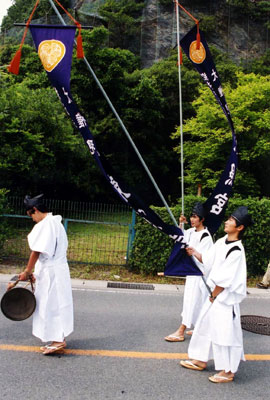|
No Image |
1.Parade magistrates Gyoretsu Bugyo |
|
|
|
2.Bell-ringing Uchigane |
|
|
|
3.Shrine flag Jinki |
|
|
|
4.Spear flags Hokobata |
|
|
No Image |
5.General magistrate So-Bugyo |
|
|
|
6.Handmaiden Koshimoto |
|
|
|
7.Musicians Reijin |
|
|
No Image |
8.Shrine maidens Miko |
|
|
|
9.Left and Right Ministers Sadaiji and Udaijin |
|
|
|
10.Ritual wand and priest Gohei and Shinkan |
|
|
|
11.Offering box and sacred branch Onkarabitsu and O-sakaki |
|
|
|
12.Gongs and drums Surigane and Taiko |
|
|
|
13.Portable shrines Mikoshi |
|
|
No Image |
14.Head Priest Guji |
|
|
|
15.Sumo Sumo |
|
|
|
16.Travelling merchants Renjaku |
|
|
|
17.Fun taiko drums Uchiwa daiko |
|
| Mochi-pounding dance Mochitsuki odori |
No Image |
18.Mochi flower dance Mochibana odori |
|---|---|---|
|
|
19.Mortar stand Usuhikidai |
|
|
|
20.Performance Mochi teawase |
|
|
|
21.Mochi pounders’ dance Kine odori |
|
|
No Image |
22.Musicians Hayashikata |
|
|
No Image |
23.Mochibana umbrella holder Mochibanakasa |
|
|
24.female dance performers Maihime |
|
|
|
25.Dedication flower bed Kenkadai |
|
| Saika odori dances Saika odori |
|
26.Umbrella holder Kasahoko |
|---|---|---|
|
|
27.Club wielding with devil’s masks Tadabo |
|
|
|
28.Big drums Odaiko |
|
|
|
29.Conch shell blower Horafuki |
|
|
No Image |
30.Gong striker Hyoshigane |
|
|
No Image |
31.Flute player Fuefuki |
|
|
|
32.Club receiving performance Ukebo |
|
|
|
33.Sasara odori dance Sasara odori |
|
|
No Image |
34.Saika Ichizoku-kai Saika Ichizoku-kai |
|
|
|
35.Armored Soldiers Yoroimusha |
|
|
|
36.Naginatafuri Naginatafuri |
|
|
No Image |
37.Kohei Kohei |
|
|
|
38.Billowing cape Horo |
|
|
|
39.Mask wearers Menkaburi |
|
|
|
40.Chinese ship and boatman’s songs Tobune and Ofunauta |
|
|
No Image |
41.Warriors at the tail end Tonomusha |
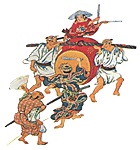
Five warriors with matchlock guns and wearing armor walk at the end of the parade. They are the guards of the parade.
This was introduced recently, and during the Edo period, the guards followed the Machi Bugyo (Magistrate) at the end of the parade, holding the three weapons of sasumata (catch fork), tsukubo (T-shaped rod), and sodegarami (multiple-headed rod).
There are various performances in Sumiyoshi Jokei’s Kishu Hontoshogu Engi painted in 1646. In this painting you can see the different floats. The tobune is the only existing float created based on the karamonoyou (Chinese design) which trended during the Muromachi period. It is recorded in the Shidaigaki written in 1622 that this Chinese ship had participated in the parade while the people of Minato-machi town played the “Fune Kako Uta” on the taiko drums, conch shell, and kotsuzumi hand drums.
During the Edo period, other sekibune (Kishu domain’s military ships) with Ofunete-kata (the domain’s navy) on board were put out to the sea by the Kishu domain in addition to this Tobune and sang boatman’s songs as part of the Wakamatsuri. And at some point, the sekibune and Tobune (Chinese ship) were combined, and Kishu domain’s Ofunete-kata came to row the tobune and sang Boatman’s songs. It could have been due to the fact that the base of ofunetr-kata was located in Minato. The Ofunete-kata wore long happi coats with navy and white checkered designs and sang ofunauta songs praising the Waka no Ura and the land of Kii Province while rowing the tobune. This was passed on by the descendants of the Ofunete-kata and their friends even after entering Meiji period. In 1980, however, when Wakamatsuri had shifted to become a commercial and industrial festival, the ofunauta was lost as people who had passed on the tradition had stopped participating and only the tobune remained.
Thanks to the research carried out by the Wakamaya Prefectural Board of Education, we were able to find the audio recordings as well as have the opportunity to meet those who had passed the song on until it was lost 30 years ago. In May 2010, ofunauta was brought back after the 30-year gap. Of the ofunauta recovered, there are the nagauta, hauta, seriuta, and yarebushi. Among them, nagauta was a special song which was sang in front of the feudal lord. And because of this, it was a difficult song which the successor was unable to sing, however, another successor of the songs who heard of the revival of the ofunauta which took place in the previous year had come to cooperate. In 2011, one of the nagauta, the amefuri was recovered.
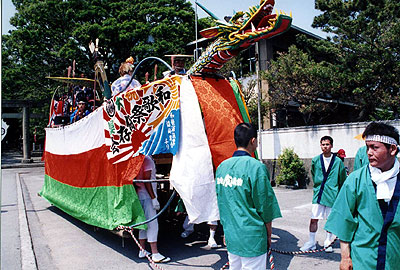
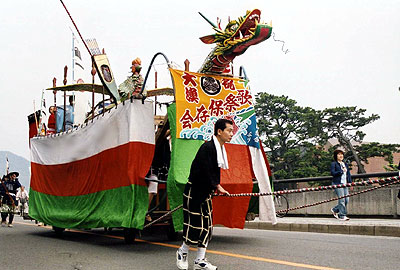
Today, called “hyakumen” (one hundred masks) by locals, menkaburi involves people wearing taka-geta (tall wooden clogs), glamorous hitatare (cort dress) and jinbaori (war coat), holding sticks with umbrellas’ and fans or instruments which make sound when they shake them. They also wear kabuki-inspired makeup and masks on their heads as they parade. When this menkaburi finds children during the parade, they use their instruments to surprise them. (In Wakanoura, it is believed that children who cry will grow healthy and strong.)
However, the current menkaburi style with makeup and umbrellas has developed as a trend since the Meiji period and is different from what was seen during the Edo period. There are various paintings remaining which show the menkaburi during the Edo period, where everyone covered their face with a mask such as the sankojo and kokushikijo, Noh masks that represent the okina (special Noh character of an old man), positioned at the front of the parade with canes in their hands. The masks used for the menkaburi are a major collection of 98 masks (which one is missing making the collection incomplete) created for noh, kyogen, and kagura performances since the Kamakura period until now, which is rarely found even across the country. Of the collection, 96 masks are designated as the Prefecture’s designated cultural heritage (the remaining two were found after the designation). The collection is diverse and includes a variety of masks which are believed to be used for religious rituals, as well as masks for noh and kyogen, and kagura. Masks associated with the tengu (legendary creature). Within this collection of valuable artifacts, there are masks made between the Momoyama and Edo period, for example, seven masks signed by artist Katahiro (made during the Muromachi period) used for sarugaku theatre performances, as well as seven Noh masks with the branding iron of a famous mask artist Tenkaichi Yukan (another name Deme Mitsuyasu) who lived at the beginning of the Edo period.
Menkaburi has been seen since the Wakamasturi festival began in 1622. Even after the order to scale down the Wakamasturi in 1665, menkaburi remained as entertainment along with the gusokugi and saika odori. It is sometimes believed that the okina mask which stands at the front of the parade is the embodiment of a god. It is also believed that menkaburi was a performance, which was regarded as highly important in the Wakamatsuri held during early Edo period.
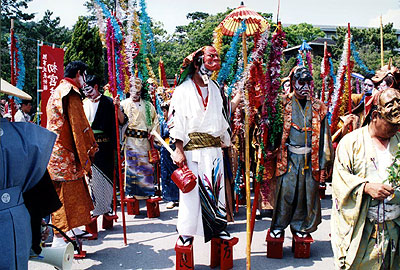
Horo is recorded in ”Shidaisho” (1622) as “neri sanjittan no ohoro” (the float consists of billowing capes as large as about 36 meters in length), and was sponsored by Koshiro, born in 1593 as the fourth son of Chaya Shiro Jiro Kiyonobu, a businessperson with political connections who served as a purveyor to Tokugawa Ieyasu, just as naginatafuri. It is believed that it was a spectacular sight as horo as heavy as 30 people’s billowing capes marched in the Togyo-Gyoretsu parade. In addition to this, three people performed with red horo sponsored by Gobo-cho. Horo also appeared in Gion Festival in Kyoto in the early Edo period, and it is considered a warrior performance along with naginagafuri and armored warriors.
Today, Wakamatsuri features red and white billowing capes. In the mid-Edo period people dressed as servants wearing happi (traditional festival costume) and keshomawashi (ornamental apron) carrying white billowing capes on their backs began to perform. It is recorded in Kiinokuni Meiisho Zue (1812) that people carrying white horo were dancing kujakumai choreography, based on what is believed to have turned into more of an art. Today, large white horo, slightly smaller red horo, and small horo carried by children march in the procession, saying “shomo, shomo,” and twirling their horo three times each side. On the morning of the day of Wakamatsuri, performers also visit houses in Wakaura for performance.
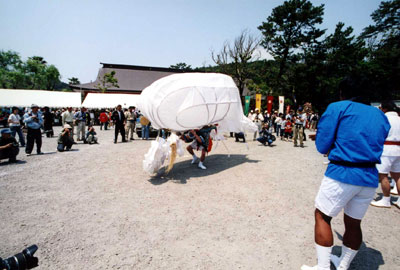
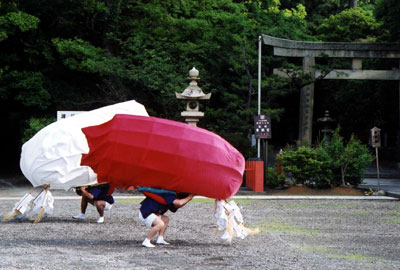
Edo period-styled armored warriors began to perform as armed warriors separately from armored warriors as a result of the Wakamatsuri restructure in the Meiji period. Armored warriors were already performing the same way as today’s horo dance – twirling flags with red circles on white backgrounds (nobori) three times each side.
Today, Naginagafuri at Wakamatsuri is a combination of more than 10 techniques including the most basic “maemawashi,” “katamawashi,” and “uguisudaniwatari.” This is the performance art that requires the highest level of skills of all Wakamatsuri performance arts.
Naginatafuri is mentioned as “ichihito naginagafuri” in “Shidaisho” (1622). The person behind the naginatafuri performance at the time was Chaya Koshiro, born in 1593 as the fourth son of Chaya Shiro Jiro Kiyonobu, a seisho (businessperson with political contacts) from Kyoto who served as a purveyor to Tokugawa Ieyasu just as with horo (samurai’s billowing cape) etc. Also depicted in “Toshogu Engi Emaki” (1646) is a person wearing black jinbaori and tattsukebakama who throws a naginata high into the air. However, the naginatafuri performance mentioned in “Waka-gosairei-omasugaki” (circa 1665) was organized by Kitashin-machi to become the first performing art that went off Koshiro Chaya’s hands.
As for the origin of Naginata furi, in relation to Wakamatsuri, which centered around kasahoko in the Edo period, recent years have seen opinions that it may be related to stick swinging that is similar to saika odori (tadabo and ukebo). It is also believed that it is related to similar performing arts in the Kinki region such as Sanyare Festival (Moriyama) and Kenketo Festival (Ryuo). The naginata swords used in Wakamatsuri had tassels attached to both ends of their handles from the mid-Edo period onward, based on which it is believed that this military art turned into more of an art.
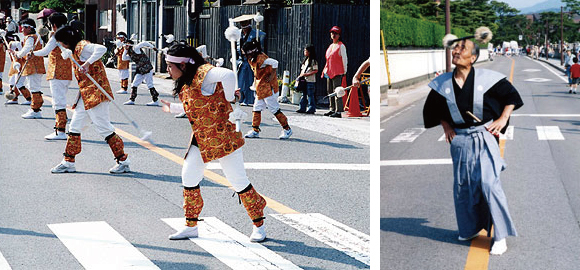
Yoroimusha joined the Togyo Gyoretsu when Wakamatsuri first began. They were referred to as “yoroimusha” or “yoroigi,” and were placed at the end of the float. For this reason, they are given the role of leading the subsequent part of the procession. Yoroimusha appear with hatasashimono (banner) called “nobori” inserted in the back of their armor. Today, the youth division of the Wakayama Chamber of Commerce and Industry participate in the Togyo Gyoretsu dressed as warriors all wearing red armor and flags with the crests of mallow pattern in white on purple.
It is recorded that there were also 150 warriors dressed similarly carrying nobori (banners) in festivals at NikkoToshogu and Nagoya Toshogu (one of the big three) in the Edo period. For this reason, it is believed that it was an established warrior performance in the Toshogu festival.
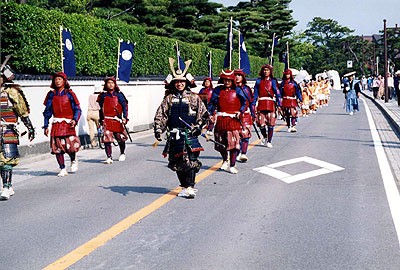
Members of the Saika Ichizoku-kai, who are said to be descendants of Saika-shu, join the procession. It is believed that they were participating in the Togyo Gyoretsu parade from the late Edo period as “saikakumi tsuetsuki hitori” is depicted after “noborisashi,” which is considered an armored warrior in “Toshogu gosairei Ezu Taikan” (1872) by Kawakami Shaju that depicts Wakamatsuri in the later Edo period.
Saika dances, led by the kasahoko (placed at the back of the sasara odori procession in the Edo period), includes sasara odori dance with participants at the front acting as saika-shu people wearing armor and holding surizasara that look like swords and sheaths, tadabo and ukebo wearing oni masks and swinging sticks, and ireko wearing glamorous costumes playing odaiko drums, gongs, and conch shells.
It is believed that saika odori started as furyu odori performed by dancers playing surizasara (bamboo instrument) around kasahoko (which had been popular mainly in Kinai region since the late Muromachi period), then some Kii province-specific traditions were added to turn it into a Togyo Gyoretsu parade. Saika dance comes in various traditions. One of two similar traditions celebrate the victory of Saika-shu people led by Suzuki Magoichi that repulsed Oda Nobunaga’s army in 1577 with surizasara (bamboo instrument) used in sasara odori for its resemblance to a sword. The other one involves a dance believed to be performed by fellow believers and Saika-shu locked themselves in
Saginomori Betsuin temple in 1582 when they saw Nobunaga’s army leave on hearing the news of the Honnoji incident.
There are no records of saika odori performed as part of its Togyo Gyoretsu when the Wakamatsuri festival first started in 1622. It is believed, however, that saika odori was incorporated into the festival’s Togyo Gyoretsu early on, and became a dance based on Kinokuni’s traditions to represent the region judged from the fact that saika odori was performed in 1635 in front of Tokugawa Iemitsu, and that it was not removed when the order to downsize Wakamatsuri came into effect in 1665.
Today, saika odori is performed by the Wakaura Soccer Club’s boys dancing sasaraodori, and by the youth division of the Conservation Group dancing tadabo and ukebo. For tadabo and ukebo in particular, the performers make their own masks, and practice once a month.
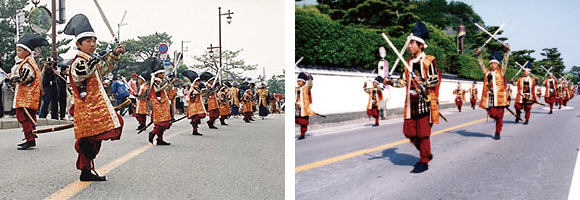
Saika dances, led by the kasahoko (placed at the back of the sasara odori procession in the Edo period), includes sasara odori dance with participants at the front acting as saika-shu people wearing armor and holding surizasara that look like swords and sheaths, tadabo and ukebo wearing oni masks and swinging sticks, and ireko wearing glamorous costumes playing odaiko drums, gongs, and conch shells.
It is believed that saika odori started as furyu odori performed by dancers playing surizasara (bamboo instrument) around kasahoko (which had been popular mainly in Kinai region since the late Muromachi period), then some Kii province-specific traditions were added to turn it into a Togyo Gyoretsu parade. Saika dance comes in various traditions. One of two similar traditions celebrate the victory of Saika-shu people led by Suzuki Magoichi that repulsed Oda Nobunaga’s army in 1577 with surizasara (bamboo instrument) used in sasara odori for its resemblance to a sword. The other one involves a dance believed to be performed by fellow believers and Saika-shu locked themselves in
Saginomori Betsuin temple in 1582 when they saw Nobunaga’s army leave on hearing the news of the Honnoji incident.
There are no records of saika odori performed as part of its Togyo Gyoretsu when the Wakamatsuri festival first started in 1622. It is believed, however, that saika odori was incorporated into the festival’s Togyo Gyoretsu early on, and became a dance based on Kinokuni’s traditions to represent the region judged from the fact that saika odori was performed in 1635 in front of Tokugawa Iemitsu, and that it was not removed when the order to downsize Wakamatsuri came into effect in 1665.
Today, saika odori is performed by the Wakaura Soccer Club’s boys dancing sasaraodori, and by the youth division of the Conservation Group dancing tadabo and ukebo. For tadabo and ukebo in particular, the performers make their own masks, and practice once a month.
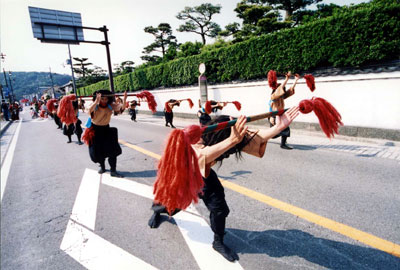
Saika dances, led by the kasahoko (placed at the back of the sasara odori procession in the Edo period), includes sasara odori dance with participants at the front acting as saika-shu people wearing armor and holding surizasara that look like swords and sheaths, tadabo and ukebo wearing oni masks and swinging sticks, and ireko wearing glamorous costumes playing odaiko drums, gongs, and conch shells.
It is believed that saika odori started as furyu odori performed by dancers playing surizasara (bamboo instrument) around kasahoko (which had been popular mainly in Kinai region since the late Muromachi period), then some Kii province-specific traditions were added to turn it into a Togyo Gyoretsu parade. Saika dance comes in various traditions. One of two similar traditions celebrate the victory of Saika-shu people led by Suzuki Magoichi that repulsed Oda Nobunaga’s army in 1577 with surizasara (bamboo instrument) used in sasara odori for its resemblance to a sword. The other one involves a dance believed to be performed by fellow believers and Saika-shu locked themselves in
Saginomori Betsuin temple in 1582 when they saw Nobunaga’s army leave on hearing the news of the Honnoji incident.
There are no records of saika odori performed as part of its Togyo Gyoretsu when the Wakamatsuri festival first started in 1622. It is believed, however, that saika odori was incorporated into the festival’s Togyo Gyoretsu early on, and became a dance based on Kinokuni’s traditions to represent the region judged from the fact that saika odori was performed in 1635 in front of Tokugawa Iemitsu, and that it was not removed when the order to downsize Wakamatsuri came into effect in 1665.
Today, saika odori is performed by the Wakaura Soccer Club’s boys dancing sasaraodori, and by the youth division of the Conservation Group dancing tadabo and ukebo. For tadabo and ukebo in particular, the performers make their own masks, and practice once a month.
Saika dances, led by the kasahoko (placed at the back of the sasara odori procession in the Edo period), includes sasara odori dance with participants at the front acting as saika-shu people wearing armor and holding surizasara that look like swords and sheaths, tadabo and ukebo wearing oni masks and swinging sticks, and ireko wearing glamorous costumes playing odaiko drums, gongs, and conch shells.
It is believed that saika odori started as furyu odori performed by dancers playing surizasara (bamboo instrument) around kasahoko (which had been popular mainly in Kinai region since the late Muromachi period), then some Kii province-specific traditions were added to turn it into a Togyo Gyoretsu parade. Saika dance comes in various traditions. One of two similar traditions celebrate the victory of Saika-shu people led by Suzuki Magoichi that repulsed Oda Nobunaga’s army in 1577 with surizasara (bamboo instrument) used in sasara odori for its resemblance to a sword. The other one involves a dance believed to be performed by fellow believers and Saika-shu locked themselves in
Saginomori Betsuin temple in 1582 when they saw Nobunaga’s army leave on hearing the news of the Honnoji incident.
There are no records of saika odori performed as part of its Togyo Gyoretsu when the Wakamatsuri festival first started in 1622. It is believed, however, that saika odori was incorporated into the festival’s Togyo Gyoretsu early on, and became a dance based on Kinokuni’s traditions to represent the region judged from the fact that saika odori was performed in 1635 in front of Tokugawa Iemitsu, and that it was not removed when the order to downsize Wakamatsuri came into effect in 1665.
Today, saika odori is performed by the Wakaura Soccer Club’s boys dancing sasaraodori, and by the youth division of the Conservation Group dancing tadabo and ukebo. For tadabo and ukebo in particular, the performers make their own masks, and practice once a month.
Saika dances, led by the kasahoko (placed at the back of the sasara odori procession in the Edo period), includes sasara odori dance with participants at the front acting as saika-shu people wearing armor and holding surizasara that look like swords and sheaths, tadabo and ukebo wearing oni masks and swinging sticks, and ireko wearing glamorous costumes playing odaiko drums, gongs, and conch shells.
It is believed that saika odori started as furyu odori performed by dancers playing surizasara (bamboo instrument) around kasahoko (which had been popular mainly in Kinai region since the late Muromachi period), then some Kii province-specific traditions were added to turn it into a Togyo Gyoretsu parade. Saika dance comes in various traditions. One of two similar traditions celebrate the victory of Saika-shu people led by Suzuki Magoichi that repulsed Oda Nobunaga’s army in 1577 with surizasara (bamboo instrument) used in sasara odori for its resemblance to a sword. The other one involves a dance believed to be performed by fellow believers and Saika-shu locked themselves in
Saginomori Betsuin temple in 1582 when they saw Nobunaga’s army leave on hearing the news of the Honnoji incident.
There are no records of saika odori performed as part of its Togyo Gyoretsu when the Wakamatsuri festival first started in 1622. It is believed, however, that saika odori was incorporated into the festival’s Togyo Gyoretsu early on, and became a dance based on Kinokuni’s traditions to represent the region judged from the fact that saika odori was performed in 1635 in front of Tokugawa Iemitsu, and that it was not removed when the order to downsize Wakamatsuri came into effect in 1665.
Today, saika odori is performed by the Wakaura Soccer Club’s boys dancing sasaraodori, and by the youth division of the Conservation Group dancing tadabo and ukebo. For tadabo and ukebo in particular, the performers make their own masks, and practice once a month.
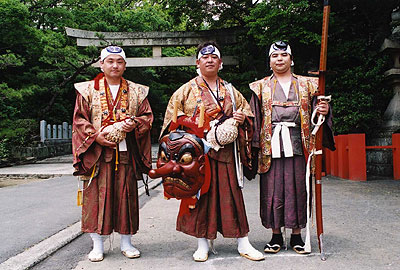
Saika dances, led by the kasahoko (placed at the back of the sasara odori procession in the Edo period), includes sasara odori dance with participants at the front acting as saika-shu people wearing armor and holding surizasara that look like swords and sheaths, tadabo and ukebo wearing oni masks and swinging sticks, and ireko wearing glamorous costumes playing odaiko drums, gongs, and conch shells.
It is believed that saika odori started as furyu odori performed by dancers playing surizasara (bamboo instrument) around kasahoko (which had been popular mainly in Kinai region since the late Muromachi period), then some Kii province-specific traditions were added to turn it into a Togyo Gyoretsu parade. Saika dance comes in various traditions. One of two similar traditions celebrate the victory of Saika-shu people led by Suzuki Magoichi that repulsed Oda Nobunaga’s army in 1577 with surizasara (bamboo instrument) used in sasara odori for its resemblance to a sword. The other one involves a dance believed to be performed by fellow believers and Saika-shu locked themselves in
Saginomori Betsuin temple in 1582 when they saw Nobunaga’s army leave on hearing the news of the Honnoji incident.
There are no records of saika odori performed as part of its Togyo Gyoretsu when the Wakamatsuri festival first started in 1622. It is believed, however, that saika odori was incorporated into the festival’s Togyo Gyoretsu early on, and became a dance based on Kinokuni’s traditions to represent the region judged from the fact that saika odori was performed in 1635 in front of Tokugawa Iemitsu, and that it was not removed when the order to downsize Wakamatsuri came into effect in 1665.
Today, saika odori is performed by the Wakaura Soccer Club’s boys dancing sasaraodori, and by the youth division of the Conservation Group dancing tadabo and ukebo. For tadabo and ukebo in particular, the performers make their own masks, and practice once a month.
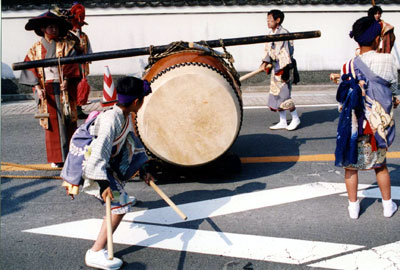
Saika dances, led by the kasahoko (placed at the back of the sasara odori procession in the Edo period), includes sasara odori dance with participants at the front acting as saika-shu people wearing armor and holding surizasara that look like swords and sheaths, tadabo and ukebo wearing oni masks and swinging sticks, and ireko wearing glamorous costumes playing odaiko drums, gongs, and conch shells.
It is believed that saika odori started as furyu odori performed by dancers playing surizasara (bamboo instrument) around kasahoko (which had been popular mainly in Kinai region since the late Muromachi period), then some Kii province-specific traditions were added to turn it into a Togyo Gyoretsu parade. Saika dance comes in various traditions. One of two similar traditions celebrate the victory of Saika-shu people led by Suzuki Magoichi that repulsed Oda Nobunaga’s army in 1577 with surizasara (bamboo instrument) used in sasara odori for its resemblance to a sword. The other one involves a dance believed to be performed by fellow believers and Saika-shu locked themselves in
Saginomori Betsuin temple in 1582 when they saw Nobunaga’s army leave on hearing the news of the Honnoji incident.
There are no records of saika odori performed as part of its Togyo Gyoretsu when the Wakamatsuri festival first started in 1622. It is believed, however, that saika odori was incorporated into the festival’s Togyo Gyoretsu early on, and became a dance based on Kinokuni’s traditions to represent the region judged from the fact that saika odori was performed in 1635 in front of Tokugawa Iemitsu, and that it was not removed when the order to downsize Wakamatsuri came into effect in 1665.
Today, saika odori is performed by the Wakaura Soccer Club’s boys dancing sasaraodori, and by the youth division of the Conservation Group dancing tadabo and ukebo. For tadabo and ukebo in particular, the performers make their own masks, and practice once a month.
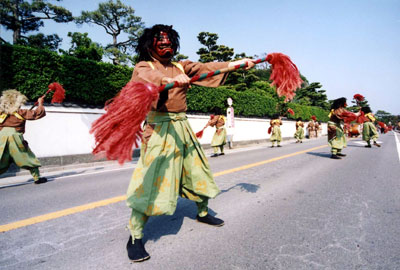
Saika dances, led by the kasahoko (placed at the back of the sasara odori procession in the Edo period), includes sasara odori dance with participants at the front acting as saika-shu people wearing armor and holding surizasara that look like swords and sheaths, tadabo and ukebo wearing oni masks and swinging sticks, and ireko wearing glamorous costumes playing odaiko drums, gongs, and conch shells.
It is believed that saika odori started as furyu odori performed by dancers playing surizasara (bamboo instrument) around kasahoko (which had been popular mainly in Kinai region since the late Muromachi period), then some Kii province-specific traditions were added to turn it into a Togyo Gyoretsu parade. Saika dance comes in various traditions. One of two similar traditions celebrate the victory of Saika-shu people led by Suzuki Magoichi that repulsed Oda Nobunaga’s army in 1577 with surizasara (bamboo instrument) used in sasara odori for its resemblance to a sword. The other one involves a dance believed to be performed by fellow believers and Saika-shu locked themselves in
Saginomori Betsuin temple in 1582 when they saw Nobunaga’s army leave on hearing the news of the Honnoji incident.
There are no records of saika odori performed as part of its Togyo Gyoretsu when the Wakamatsuri festival first started in 1622. It is believed, however, that saika odori was incorporated into the festival’s Togyo Gyoretsu early on, and became a dance based on Kinokuni’s traditions to represent the region judged from the fact that saika odori was performed in 1635 in front of Tokugawa Iemitsu, and that it was not removed when the order to downsize Wakamatsuri came into effect in 1665.
Today, saika odori is performed by the Wakaura Soccer Club’s boys dancing sasaraodori, and by the youth division of the Conservation Group dancing tadabo and ukebo. For tadabo and ukebo in particular, the performers make their own masks, and practice once a month.
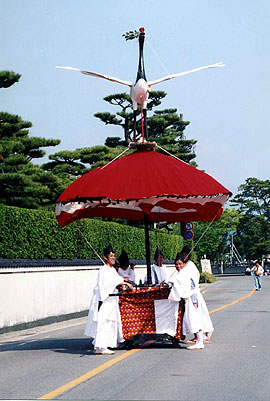
During the Showa 40s (1965 – 1975) this was added as a new entertainment along with koshimoto (female servants) accompanying the daimyo palanquin procession. This was a female-only procession of women wearing katsugi (thing garment) on their heads who walked slowly and quietly. Dancing girls at the time only walked in dance costumes with no dance performances. However, Kazuko Nakamura, leading dancer, asked a nagauta shamisen master and a traditional Japanese dance master in 2004 for assistance in creating a dance with choreography involving movements of bouncing Kishu temari. Today, every spring sees female participants in their 20’s as well as recruits from local elementary and junior high schools joining the ranks. They practice their dance in the tatami room of Kimuraya prior to participating in the Wakamatsuri festival.
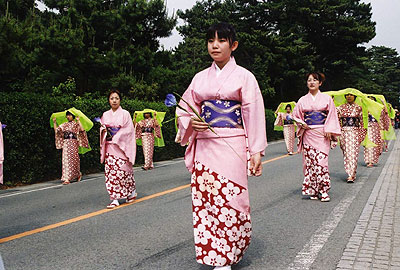
Mochibanaodori is a parade float that began to exist when Wakamatsuri first started in 1622. In ”Kishuhon Toshogu Engi” (1646), mochininai, mochibana, eboshigi, “Mochitsuki odori” (mallet holder, mill pounder, teawase performance), musicians (flute, drum, hand drum), and mochibana kasahoko (umbrealla holder) are all depicted as part of a mochibana odori. The order to downsize the festival in 1665 meant the dance ceased to exist from the following year. However, it was revived in 1800 by Takechi Shiyu, the editor of “Kiinokuni Meisho Zue.” The revived Mochitsuki odori also consisted of multiple items such as uchiwa daiko, based on junrei dance by a man wearing an eboshi, Mochibana odori, “Mochitsuki odori” (mallet holder, mill pounder, teawase performance), musicians (flute, drum, hand drum, surigane), and Mochibana kasahoko (umbrella holder). Due to ageing and lack of successors, the musicians’ performance ceased to exist in the Showa 50s (1975-1985), leaving only the “yah-oh, in-yah, ah-oh” call and shime daiko (finishing drum). However, the performance was revived in 2012 based on video owned by Takarazuka Revue Company’s Local Performing Arts Research Department.
Mochibanaodori is a parade float that began to exist when Wakamatsuri first started in 1622. In ”Kishuhon Toshogu Engi” (1646), mochininai, mochibana, eboshigi, “Mochitsuki odori” (mallet holder, mill pounder, teawase performance), musicians (flute, drum, hand drum), and mochibana kasahoko (umbrealla holder) are all depicted as part of a mochibana odori. The order to downsize the festival in 1665 meant the dance ceased to exist from the following year. However, it was revived in 1800 by Takechi Shiyu, the editor of “Kiinokuni Meisho Zue.” The revived Mochitsuki odori also consisted of multiple items such as uchiwa daiko, based on junrei dance by a man wearing an eboshi, Mochibana odori, “Mochitsuki odori” (mallet holder, mill pounder, teawase performance), musicians (flute, drum, hand drum, surigane), and Mochibana kasahoko (umbrella holder). Due to ageing and lack of successors, the musicians’ performance ceased to exist in the Showa 50s (1975-1985), leaving only the “yah-oh, in-yah, ah-oh” call and shime daiko (finishing drum). However, the performance was revived in 2012 based on video owned by Takarazuka Revue Company’s Local Performing Arts Research Department.
Mochibanaodori is a parade float that began to exist when Wakamatsuri first started in 1622. In ”Kishuhon Toshogu Engi” (1646), mochininai, mochibana, eboshigi, “Mochitsuki odori” (mallet holder, mill pounder, teawase performance), musicians (flute, drum, hand drum), and mochibana kasahoko (umbrealla holder) are all depicted as part of a mochibana odori. The order to downsize the festival in 1665 meant the dance ceased to exist from the following year. However, it was revived in 1800 by Takechi Shiyu, the editor of “Kiinokuni Meisho Zue.” The revived Mochitsuki odori also consisted of multiple items such as uchiwa daiko, based on junrei dance by a man wearing an eboshi, Mochibana odori, “Mochitsuki odori” (mallet holder, mill pounder, teawase performance), musicians (flute, drum, hand drum, surigane), and Mochibana kasahoko (umbrella holder). Due to ageing and lack of successors, the musicians’ performance ceased to exist in the Showa 50s (1975-1985), leaving only the “yah-oh, in-yah, ah-oh” call and shime daiko (finishing drum). However, the performance was revived in 2012 based on video owned by Takarazuka Revue Company’s Local Performing Arts Research Department.
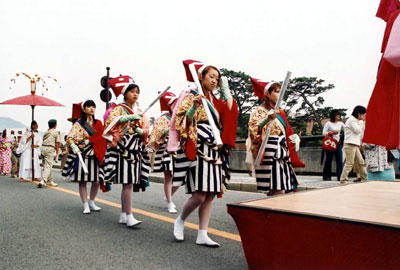
Mochibanaodori is a parade float that began to exist when Wakamatsuri first started in 1622. In ”Kishuhon Toshogu Engi” (1646), mochininai, mochibana, eboshigi, “Mochitsuki odori” (mallet holder, mill pounder, teawase performance), musicians (flute, drum, hand drum), and mochibana kasahoko (umbrealla holder) are all depicted as part of a mochibana odori. The order to downsize the festival in 1665 meant the dance ceased to exist from the following year. However, it was revived in 1800 by Takechi Shiyu, the editor of “Kiinokuni Meisho Zue.” The revived Mochitsuki odori also consisted of multiple items such as uchiwa daiko, based on junrei dance by a man wearing an eboshi, Mochibana odori, “Mochitsuki odori” (mallet holder, mill pounder, teawase performance), musicians (flute, drum, hand drum, surigane), and Mochibana kasahoko (umbrella holder). Due to ageing and lack of successors, the musicians’ performance ceased to exist in the Showa 50s (1975-1985), leaving only the “yah-oh, in-yah, ah-oh” call and shime daiko (finishing drum). However, the performance was revived in 2012 based on video owned by Takarazuka Revue Company’s Local Performing Arts Research Department.
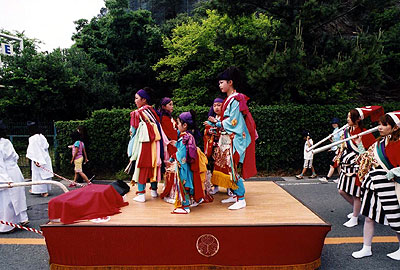
Mochibanaodori is a parade float that began to exist when Wakamatsuri first started in 1622. In ”Kishuhon Toshogu Engi” (1646), mochininai, mochibana, eboshigi, “Mochitsuki odori” (mallet holder, mill pounder, teawase performance), musicians (flute, drum, hand drum), and mochibana kasahoko (umbrealla holder) are all depicted as part of a mochibana odori. The order to downsize the festival in 1665 meant the dance ceased to exist from the following year. However, it was revived in 1800 by Takechi Shiyu, the editor of “Kiinokuni Meisho Zue.” The revived Mochitsuki odori also consisted of multiple items such as uchiwa daiko, based on junrei dance by a man wearing an eboshi, Mochibana odori, “Mochitsuki odori” (mallet holder, mill pounder, teawase performance), musicians (flute, drum, hand drum, surigane), and Mochibana kasahoko (umbrella holder). Due to ageing and lack of successors, the musicians’ performance ceased to exist in the Showa 50s (1975-1985), leaving only the “yah-oh, in-yah, ah-oh” call and shime daiko (finishing drum). However, the performance was revived in 2012 based on video owned by Takarazuka Revue Company’s Local Performing Arts Research Department.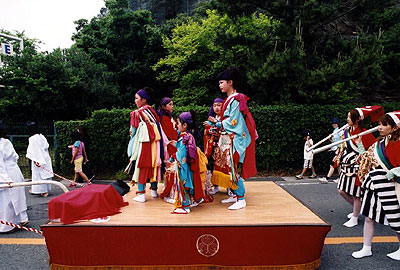
Mochibanaodori is a parade float that began to exist when Wakamatsuri first started in 1622. In ”Kishuhon Toshogu Engi” (1646), mochininai, mochibana, eboshigi, “Mochitsuki odori” (mallet holder, mill pounder, teawase performance), musicians (flute, drum, hand drum), and mochibana kasahoko (umbrealla holder) are all depicted as part of a mochibana odori. The order to downsize the festival in 1665 meant the dance ceased to exist from the following year. However, it was revived in 1800 by Takechi Shiyu, the editor of “Kiinokuni Meisho Zue.” The revived Mochitsuki odori also consisted of multiple items such as uchiwa daiko, based on junrei dance by a man wearing an eboshi, Mochibana odori, “Mochitsuki odori” (mallet holder, mill pounder, teawase performance), musicians (flute, drum, hand drum, surigane), and Mochibana kasahoko (umbrella holder). Due to ageing and lack of successors, the musicians’ performance ceased to exist in the Showa 50s (1975-1985), leaving only the “yah-oh, in-yah, ah-oh” call and shime daiko (finishing drum). However, the performance was revived in 2012 based on video owned by Takarazuka Revue Company’s Local Performing Arts Research Department.
It is said that uchiwadaiko began as a performing art in honor of Oman no Kata, the birth mother of Tokugawa Yorinobu, who was a dedicated Nichiren believer. Waka-gosairei-omasugaki (1665) records 33 participants in junrei dance (dedicated to the deity in the shrine) from 10 towns including Yorozu-cho and Nishinomise. However, the order to downsize the Wakamatsuri Festival that came into effect in the following year meant this dance ceased to exist. However, Takechi Shiyu, the editor of “Kiinokuni Meisho Zue” revived it in 1800 as one of the dances that are performed in the motchitsuki odori (Mochi-pounding dance). Today, it is performed by children just as the motchibana odori (Mochi flower dance) is.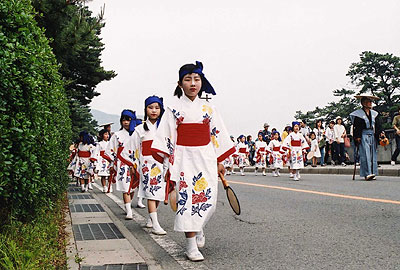
Renjaku is a costume parade of people dressed as hawkers carrying a chest with textile fabrics on top on a renjaku. The renjaku (peddler) is depicted as part of Wakamatsuri in Waka-gosairei-zu byobu (The folding screen of Wakamatsuri Festival,circa 1665). As Waka-gosairei-omasugaki, which was created around the same time, says ”1. Five renjaku/come out of the tea house on the right,” it is believed that Chaya Koshiro, born in 1593, the fourth son of Chaya Shirojiro Kiyonobu, a purveyor to Tokugawa Ieyasu based in Kyoto was the organizer of the renjaku peddlers. The renjaku was depicted in pictures after 1665 with various figures including men, boys, and males dressed as women. Although they used to twirl umbrellas in and after the Meiji Era, there are no pictures from the Edo period with renjaku holding umbrellas. Therefore, this did not exist at the time.
Today, “renjaku” with two adults who reside in Wakaura, and “children’s renjaku” with elementary school children are part of the procession.
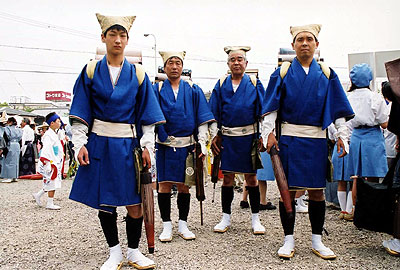
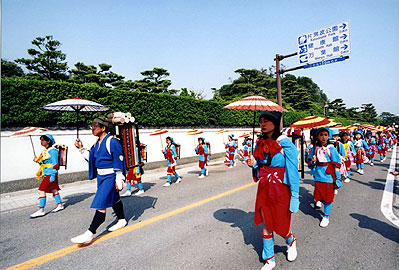
Sumo, referred to as sumai-no-sechie since ancient times, is an entertainment that has been performed at various festivals including at the imperial court during boys’ festivals.
It has been dedicated before the altar in the otabisho for the Wakamatsuri since its foundation. It is thought that this dedicatory sumo match was performed under the festival magistrate, Asahina Sozaemon, and had the sumo referee, Yoshida Hayate, and wrestlers who followed him from Suruga. It was not part of the Togyo Gyoretsu parade at the time. By the later Edo period, however, those wrestlers who resided in the castle town as well as villages within the domain territories also began to participate in the parade in addition to their duties at the otabisho.
Today, amateur wrestlers in the prefecture who belong to the Wakayamaken Sumo Federation participate in the parade and compete in the ring.
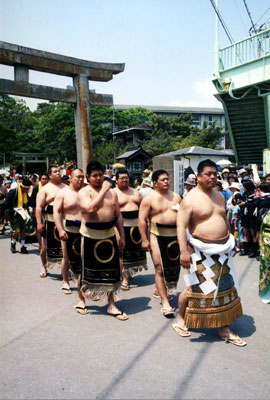
Toshogu festivals including Wakamatsuri are performed in the Sanno Ichijitsu Shinto style, which was developed by Tenkai based on Sanno Shinto. Based on this Shintoism, three mikoshi were carried (Tosho Daigongen, Sanno Gongen and Matarajin) during the Togyo Gyoretsu parade at Wakamatsuri in the Edo period. However, as part of the anti-Buddhism movement in 1871, the Sanno Gongen and Matarajin mikoshi were forced to relocate to another shrine. Subsequently, the festival continued with the Tosho Daigongen mikoshi only, but recent years have seen the addition of more mikoshi to the Wakamatsuri festival such as gosho mikoshi accompanied by goshoguruma, joshi mikoshi carried by women only, and kodomo mikoshi carried by elementary school children from the Wakanoura Elementary School.
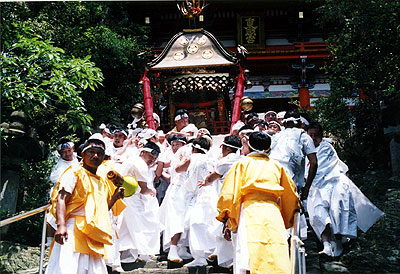
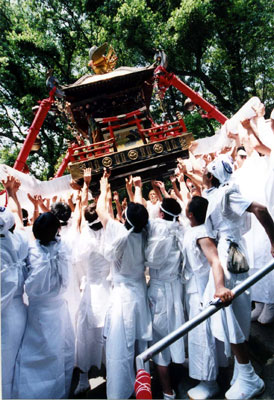
Today, surigane and taiko are the most symbolic of the various performance arts that are part of Wakamatsuri. In the Edo period, some residents of Waka village called “miyashita” played various roles including carrying portable shrines and playing gongs and drums . Surigane are still played by the residents of Wakanoura, who have inherited several ways of playing. During kane-oroshi, held on May 1, surigane and taiko are beat to declare the beginning of Wakamatsuri.
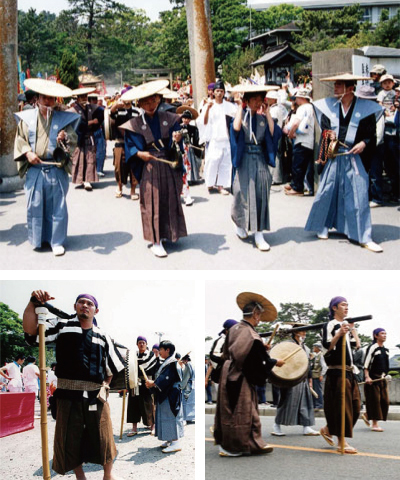
Onkarabitsu box housing offerings at the otabisho, and an osakaki branch inserted into a base. People from the Wakanoura Fisheries Cooperative Association carry these, just as with the mikoshi. The word “sakaki” is said to come from “sakaki,” a forest that lies between the gods and humans. Okasaki plays a role of marking a clear spatial separation between the gods and humans before the appearance of a mikoshi (portable shrine) that follows.
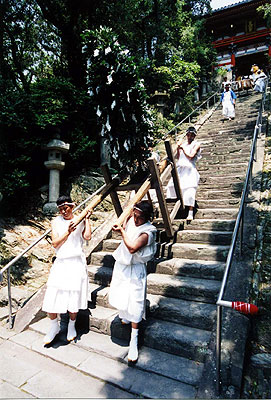
This role imitates the Sadaijin (Minister of the Left, Sakonoechujo post) and the Udaijin (Minister of the Right, Ukonoeshosho post) wearing kettekinoho, a black and scarlet garment for military officers. This role was modelled after the bodyguard for the Konoefu (Imperial Guard Office) that protected the emperor and began to join the parade after the war as a parade guard just as the female servants did .
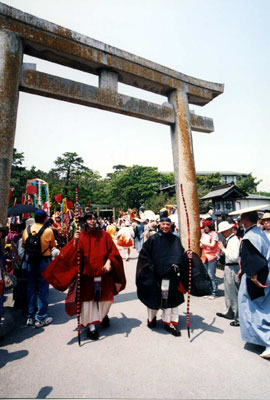
When Wakamatsuri first began, yaotome (eight shrine maidens) and kaguraotoko (male kagura performers) would appear as in other Toshogu festivals. However, by the early Edo period, they began to be replaced by miko. These miko were recorded as kannagi, Goto Kizu, 6 koku (stipend paid in rice) in the Kii Zoku Fudoki Vol. 1 (1839), and were a dedicated miko living in mansions in Higashi-nagamachi given by the clan. The pond Kaminoko existed around Higashi-nagamachi until the Taisho era. The whereabouts of this house are not known today, and women from Wakanoura acting as miko (shrine maiden) have been participating in the parade since the Meiji era.
During the Edo period, reijin were referred to as gakunin (also means “musicians” or “performers”) and performed court dances and music as rituals at otabisho (temporary destinations and stops located on pathways which portable shrines were carried). They performed as a dedication at various ceremonies of Toshogu shrines such as Nikko Toshogu and Nagoya Toshogu. Especially at Nikko Toshogu, Azuma Asobi (“Eastern Play”), the popular dances of the people of the area where Tokugawa Ieyasu was initially buried (Udohama area at the foot of Mt. Kuno). This developed into the Kuniburi no utamai (traditional dance and music unique to Japan, without the influence of other cultures), and other various dances and music were performed. When Wakamatsuri first started, no dances were included as part of the festival. This dance, however, is thought to have been established before 1630 on grounds including the fact that a dedicatory dance for a festival at Toshogu in Nagoya which began in 1630 with gakunin invited from Kyoto came as a result of the decision made by Tokugawa Yoshinao, Owari Domain lord, in consultation with Tokugawa Yorinobu. It is believed that the gakunin who were dedicating their dance to Wakamatsuri also came on invitation from sanpo-gakuso (three groups of Japanese court music performers based in kyuchu-gata in Kyoto; nanto-gata in Nara; and Tennoji-gata in Osaka). By the late Edo period, however, Kamo (Shimotsu-cho, Kainan City) and other local gakunin began to join the dance.
The dance at the otabisho for Wakamtsuri has now stopped to exist. However, during the Togyo Gyoretsu parade, a Japanese court music band called Wakayama Gagakukai (formed in 1948) play hyojo-scale pieces of “Etenraku” and “Gojoraku” as michigaku with sho (mouth-organ), hichiriki (oboe), ryuteki (flute) and drums in response to chief priest, Hidenori Nishikawa’s invitation.
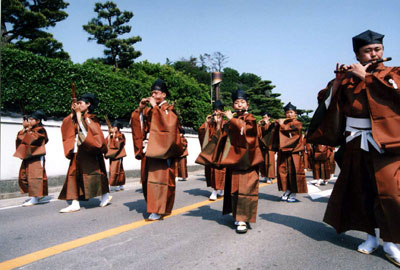
This section of the parade replicates the handmaidens of the Kishu clan. Koshimoto wear a kimono with yagasuri (arrow feathers) patterns and hold shobu iris flowers as they parade. During the years of 1965-75 after WWII when Wakamatsuri was the commercial and industrial festival of Wakayama City, it was added to the parade along with the maihime (female dance performers) as part of those who follow the daimyo. Currently, koshimoto are chosen from the public who apply to the role.
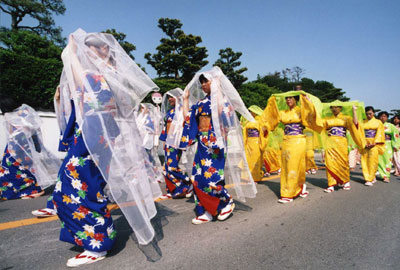
During the Edo period, the parade was always accompanied by the Machi-Bugyo (Town magistrate) The Machi-Bugyo had attendants with “the three tools” of sasumata, tsukubo, and sodegarami, which are all types of pole weapons used during feudal Japan. They were responsible for supporting the event making sure it was carried out safely.
Nowadays, the directors of the Wakamatsuri Preservation Committee walk at the front of the parade and take the roles of the So-Bugyo, in charge of management. The members of the Wakamatsuri Organization Committee follow them as the attendees.
Five hokobata varying in colors of green, yellow, red, white, and navy are carried on carriages. These hokobata are associated with the seven ohataboko (flag spears) decorated with grand spears and metal ornaments which were seen at the beginning of the Edo period (1603-1867). Ohataboko are referred to as kenboko (blade spears) in Kyoto and are seen during festivals across the country. In Kyoto, the hokosashi (person carrying the kenboko) holding the kenboko by him/herself is one of the major attractions of the ceremonies. Due to the fact that there were eight kenboko (called matsuriboko) used during the ceremony when it started at Nikko Toshogu Shrine, the seven kenboko carried by the hokoshashi were introduced at the Wakamatsuri during the Edo period as it held the same status of being a Toshogu.
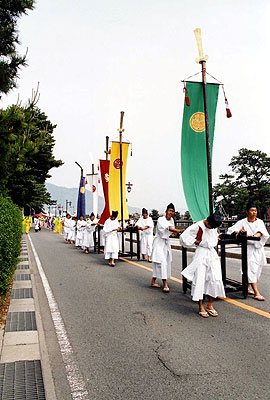
The shrine’s crest (shinmon), triple hollyhock is printed gold on a navy background with the characters of 「紀州和歌浦大権現 東照宮」(Kishu Wakanoura Daigongen, Toshogu) is left undyed and appear in white on the flag. This flag along with the bells notify the people of the arrival of the parade.
